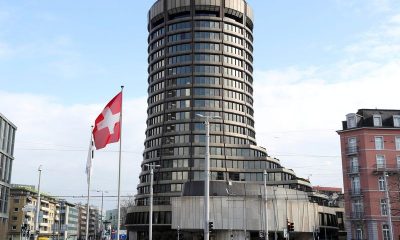Economy
Why is the Canadian economy strong despite record pace of rate hikes?

Despite the fastest monetary tightening cycle in the country’s history, Canada’s economy is still running hot, which forced the central bank to crank its key interest rate even higher to a 22-year high of 4.75% last week.
Analysts are betting on another rate hike in July, to help the Bank of Canada bring inflation back down to its 2% range. Here are some factors that are keeping demand robust in the Canadian economy.
EXTENDED MORTGAGE AMORTIZATIONS
Many of Canada’s major banks allowed holders of variable rate mortgages to extend their amortization period in order to keep their payments at nearly the same level, temporarily blunting the impact of higher borrowing costs.
As a result, higher borrowing costs have so far caused less financial stress for home buyers than they had expected, so the market has not seen a spike in supply from forced sellers.
That has partially helped the recovery in home prices, which have jumped 17% in the three months since January, after a year-long slump.
“It’s really something that has been a game changer in terms of how monetary policy is transmitted to the economy,” said Randall Bartlett, senior director of Canadian economics at Desjardins.
“A lot of households have been able to continue spending in a way that they wouldn’t otherwise be able to, and to stay in their homes in a way that they wouldn’t otherwise be able to.”
POST-PANDEMIC SPLURGE
Canadian consumers have been splurging on interest-rate sensitive sectors including durable goods like furniture and appliances, despite a 1% decline in disposable income in the first quarter, drawing down their pandemic savings. The savings rate has halved to 2.9% in the first quarter from the fourth quarter of last year, Statistics Canada said.
“It seems like a lot of Canadians are looking to catch up on experiences that they weren’t able to have for a couple of years,” like traveling and eating out, Bartlett added.
GOVERNMENT SPENDING
To offset the impact of inflation, which peaked at 8.1% last year, the federal and provincial governments have passed affordability measures, such as a federal C$2.5 billion ($1.9 billion) one-time grocery rebate for low earners that was in this year’s budget.
Provinces have enacted a number of different measures, including cutting taxes on fuel. Provincial stimulus measures are estimated to total about C$12 billion in fiscal year 2023-2024, Bartlett said, compared with more than C$20 billion in mid-2022.
Taken together, “they all exacerbate inflation when you’re in an environment of excess demand,” Bartlett said. But he estimated it will add “much less” than one-tenth of a percentage point to inflation this year.
The central bank says the fiscal spending is not adding to inflation, but it is not helping bring it down either.
($1 = 1.3347 Canadian dollars)
Economy
Russian central bank says it needs months to make sure CPI falling before rate cuts -RBC


© Reuters. Russian Central Bank Governor Elvira Nabiullina attends a news conference in Moscow, Russia June 14, 2019. REUTERS/Shamil Zhumatov/File Photo
MOSCOW (Reuters) – Russia’s central bank will need two to three months to make sure that inflation is steadily declining before taking any decision on interest rate cuts, the bank’s governor Elvira Nabiullina told RBC media on Sunday.
The central bank raised its key interest rate by 100 basis points to 16% earlier in December, hiking for the fifth consecutive meeting in response to stubborn inflation, and suggested that its tightening cycle was nearly over.
Nabiullina said it was not yet clear when exactly the regulator would start cutting rates, however.
“We really need to make sure that inflation is steadily decreasing, that these are not one-off factors that can affect the rate of price growth in a particular month,” she said.
Nabiullina said the bank was taking into account a wide range of indicators but primarily those that “characterize the stability of inflation”.
“This will take two or three months or more – it depends on how much the wide range of indicators that characterize sustainable inflation declines,” she said.
The bank will next convene to set its benchmark rate on Feb. 16.
The governor also said the bank should have started monetary policy tightening earlier than in July, when it embarked on the rate-hiking cycle.
Economy
China identifies second set of projects in $140 billion spending plan


© Reuters. FILE PHOTO: Workers walk past an under-construction area with completed office towers in the background, in Shenzhen’s Qianhai new district, Guangdong province, China August 25, 2023. REUTERS/David Kirton/File Photo
SHANGHAI (Reuters) – China’s top planning body said on Saturday it had identified a second batch of public investment projects, including flood control and disaster relief programmes, under a bond issuance and investment plan announced in October to boost the economy.
With the latest tranche, China has now earmarked more than 800 billion yuan of its 1 trillion yuan ($140 billion) in additional government bond issuance in the fourth quarter, as it focuses on fiscal steps to shore up the flagging economy.
The National Development and Reform Commission (NDRC) said in a statement on Saturday it had identified 9,600 projects with planned investment of more than 560 billion yuan.
China’s economy, the world’s second largest, is struggling to regain its footing post-COVID-19 as policymakers grapple with tepid consumer demand, weak exports, falling foreign investment and a deepening real estate crisis.
The 1 trillion yuan in additional bond issuance will widen China’s 2023 budget deficit ratio to around 3.8 percent from 3 percent, the state-run Xinhua news agency has said.
“Construction of the projects will improve China’s flood control system, emergency response mechanism and disaster relief capabilities, and better protect people’s lives and property, so it is very significant,” the NDRC said.
The agency said it will coordinate with other government bodies to make sure that funds are allocated speedily for investment and that high standards of quality are maintained in project construction.
($1 = 7.1315 renminbi)
Economy
Russian central bank says it needs months to make sure CPI falling before rate cuts -RBC


© Reuters. Russian Central Bank Governor Elvira Nabiullina attends a news conference in Moscow, Russia June 14, 2019. REUTERS/Shamil Zhumatov/File Photo
MOSCOW (Reuters) – Russia’s central bank will need two to three months to make sure that inflation is steadily declining before taking any decision on interest rate cuts, the bank’s governor Elvira Nabiullina told RBC media on Sunday.
The central bank raised its key interest rate by 100 basis points to 16% earlier in December, hiking for the fifth consecutive meeting in response to stubborn inflation, and suggested that its tightening cycle was nearly over.
Nabiullina said it was not yet clear when exactly the regulator would start cutting rates, however.
“We really need to make sure that inflation is steadily decreasing, that these are not one-off factors that can affect the rate of price growth in a particular month,” she said.
Nabiullina said the bank was taking into account a wide range of indicators but primarily those that “characterize the stability of inflation”.
“This will take two or three months or more – it depends on how much the wide range of indicators that characterize sustainable inflation declines,” she said.
The bank will next convene to set its benchmark rate on Feb. 16.
The governor also said the bank should have started monetary policy tightening earlier than in July, when it embarked on the rate-hiking cycle.

 Forex3 years ago
Forex3 years agoForex Today: the dollar is gaining strength amid gloomy sentiment at the start of the Fed’s week

 Forex3 years ago
Forex3 years agoUnbiased review of Pocket Option broker

 Forex3 years ago
Forex3 years agoDollar to pound sterling exchange rate today: Pound plummeted to its lowest since 1985

 Forex3 years ago
Forex3 years agoHow is the Australian dollar doing today?

 Cryptocurrency3 years ago
Cryptocurrency3 years agoWhat happened in the crypto market – current events today

 World3 years ago
World3 years agoWhy are modern video games an art form?

 Commodities3 years ago
Commodities3 years agoCopper continues to fall in price on expectations of lower demand in China

 Economy3 years ago
Economy3 years agoCrude oil tankers double in price due to EU anti-Russian sanctions



























